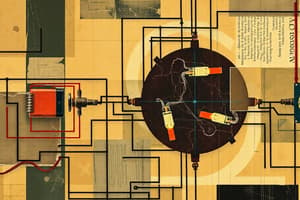Podcast
Questions and Answers
What is the equation for calculating the equivalent resistance (Req) in a series circuit?
What is the equation for calculating the equivalent resistance (Req) in a series circuit?
Req = R1 + R2 + ... + Rn
What is the formula for calculating the equivalent resistance (Req) in a parallel circuit?
What is the formula for calculating the equivalent resistance (Req) in a parallel circuit?
1/Req = 1/R1 + 1/R2 + ... + 1/Rn
What is the equivalent resistance of the series circuit shown in the image, if the resistances are R1 = 10 Ω and R2 = 3 Ω?
What is the equivalent resistance of the series circuit shown in the image, if the resistances are R1 = 10 Ω and R2 = 3 Ω?
13 Ω
What is the equivalent resistance of the parallel circuit shown in the image, if the resistances are R1 = 10 Ω and R2 = 3 Ω?
What is the equivalent resistance of the parallel circuit shown in the image, if the resistances are R1 = 10 Ω and R2 = 3 Ω?
What is the current flowing through the series circuit, if the voltage is 50 V and the equivalent resistance is 13 Ω?
What is the current flowing through the series circuit, if the voltage is 50 V and the equivalent resistance is 13 Ω?
What is the current flowing through the parallel circuit, if the voltage is 50 V and the equivalent resistance is 2.31 Ω?
What is the current flowing through the parallel circuit, if the voltage is 50 V and the equivalent resistance is 2.31 Ω?
Flashcards
Series Circuit
Series Circuit
A circuit where components are connected in a single path, so the same current flows through each component.
Parallel Circuit
Parallel Circuit
A circuit where components are connected in separate branches, so current can flow through each branch independently.
Equivalent Resistance (Req) in Series
Equivalent Resistance (Req) in Series
Represents the total resistance of all resistors in a series circuit
Req = R1 + R2 + ... + Rn
Req = R1 + R2 + ... + Rn
Signup and view all the flashcards
Current in Series Circuit
Current in Series Circuit
Signup and view all the flashcards
Voltage in Series Circuit
Voltage in Series Circuit
Signup and view all the flashcards
Equivalent Resistance (Req) in Parallel
Equivalent Resistance (Req) in Parallel
Signup and view all the flashcards
1/Req = 1/R1 + 1/R2 + ... + 1/Rn
1/Req = 1/R1 + 1/R2 + ... + 1/Rn
Signup and view all the flashcards
Current in Parallel Circuit
Current in Parallel Circuit
Signup and view all the flashcards
Voltage in Parallel Circuit
Voltage in Parallel Circuit
Signup and view all the flashcards
Resistance (R)
Resistance (R)
Signup and view all the flashcards
Current (I)
Current (I)
Signup and view all the flashcards
Voltage (V)
Voltage (V)
Signup and view all the flashcards
Voltage Source
Voltage Source
Signup and view all the flashcards
Resistor
Resistor
Signup and view all the flashcards
Ohm's Law
Ohm's Law
Signup and view all the flashcards
Simple Circuit
Simple Circuit
Signup and view all the flashcards
Complex Circuit
Complex Circuit
Signup and view all the flashcards
Node
Node
Signup and view all the flashcards
Study Notes
Series Circuits
- Circuits arranged in a single path
- Total resistance (Req) is the sum of individual resistances: Req = R₁ + R₂ + R₃ ...
- Current (I) is the same throughout the circuit
- Voltage (V) across the circuit is the sum of voltages across each resistor: V = V₁ + V₂ + V₃ ...
Parallel Circuits
- Circuits with multiple paths for current
- Reciprocal of total resistance (Req) is the sum of reciprocals of individual resistances: 1/Req = 1/R₁ + 1/R₂ + 1/R₃ ...
- Voltage (V) is the same across each branch
- Current (I) through the main line is the sum of currents through each branch: I = I₁ + I₂ + I₃ ...
Solving Circuits
-
Series Circuit Example:
- Resistances: R₁ = 10Ω, R₂ = 3Ω
- Voltage: 50V
- Total resistance: Req = R₁ + R₂ = 10Ω + 3Ω = 13Ω
- Current: I = V / Req = 50V / 13Ω = 3.85A
-
Parallel Circuit Example:
- Resistances: R₁ = 10Ω, R₂ = 3Ω
- Voltage: 50V
- Total resistance: 1/Req = 1/10Ω + 1/3Ω = (3 + 10) / 30Ω = 13/30Ω, Req = 30Ω / 13 = 2.31Ω
- Current: I = V / Req = 50V / 2.31Ω = 21.65A
Studying That Suits You
Use AI to generate personalized quizzes and flashcards to suit your learning preferences.




